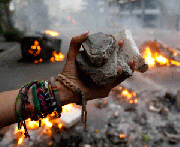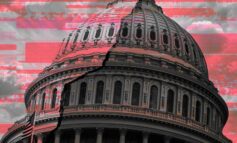The struggle will continue in Iran. This great country is on a political fault line, and its people know it.

|
|
A woman supporter demonstrator shows stones used for throwing during clashes with police in Tehran June 13, 2009. REUTERS/Ahmed Jadalla |
Liberation comes in stages. Iran needs ample time to radically change its political system. The Iranian uprising is strong enough today, but the current regime is bent on breaking the bones of those who challenge its legitimacy.
Despite the strong desire for change, Iranian society is still split between the populist and the modernist.
The populist, whom President Ahmadinejad represents, is poorly educated, extra-nationalistic and anti-Western. The populist is still hypnotized by the Khomeini power that emerged through the revolt against the regime of the pro-Western Shah.
The modernist Iranian is open-minded, globally oriented and gender sensitive. The modernist is politically awakened but not yet organized and sufficiently inclusive. The uprising should find attractive ways to draw in the rural and low income groups to the national struggle for modern state building.
Women power in this modernist group is growing rapidly, and with gender empowerment there is great potential for a sweeping socio-political movement.
Public protest requires sustained organization. There seems to be no strategic vision, no party, no identifiable social movement and no structure behind the activism in the street. It is heartening to observe that women of Iran are in the process of figuring out the relevance of political power in building democracy and in reclaiming Islam as a faith rather than a political ideology.
The revolt lacks a forceful leader. To be fair, the former prime minister, Mir Hussein Mousavi, has an impressive record. But his critics describe Mousavi as a born-again bureaucrat, who conveniently ran on a “change” message at a time when people are yearning for relief from a dysfunctional political system. Mousavi has not yet identified a vision, a forceful message for the uprising beyond “moderation” and smart economic investment.
The leadership vacuum may allow covert foreign meddling to penetrate the current Iranian uprising. The 1979 revolution was diverted from a struggle against the neo-colonial rule of the Shah, its original purpose. The revolution went through rapid metamorphoses to unfortunately become a struggle against modernity, with a religious cover. Religious leaders took over the revolution from the intellectuals.
There is a lesson to be learned. To preserve the Persian authenticity of the struggle, the leaders of this uprising should keep a distance from Western “democracy experts,” for many reasons, not the least of which is the presence of a dismal record of foreign intervention in Iran.
For the next round of revolt, women and working class leadership will hopefully take center stage. It is only a matter of a few years before the sweeping round of revolt will come.






Leave a Reply